Investigating the Variation of Benzene and 1,3-Butadiene in the UK during 2000–2020
Abstract
:1. Introduction
2. Methods
3. Results and Discussion
Cancer Impact Estimation
4. Conclusions
Supplementary Materials
Author Contributions
Funding
Institutional Review Board Statement
Informed Consent Statement
Data Availability Statement
Acknowledgments
Conflicts of Interest
Appendix A
| Benzene | 1,3-Butadiene | ||||||||
|---|---|---|---|---|---|---|---|---|---|
| Year | LMR | LE | AM | H | Year | LMR | LE | AM | H |
| 2000 | 2000 | ||||||||
| 2001 | 2001 | ||||||||
| 2002 | 2002 | ||||||||
| 2003 | 2003 | ||||||||
| 2004 | 2004 | ||||||||
| 2005 | 2005 | ||||||||
| 2006 | 2006 | ||||||||
| 2007 | 2007 | ||||||||
| 2008 | 2008 | ||||||||
| 2009 | 2009 | ||||||||
| 2010 | 2010 | ||||||||
| 2011 | 2011 | ||||||||
| 2012 | 2012 | ||||||||
| 2013 | 2013 | ||||||||
| 2014 | 2014 | ||||||||
| 2015 | 2015 | ||||||||
| 2016 | 2016 | ||||||||
| 2017 | 2017 | ||||||||
| 2018 | 2018 | ||||||||
| 2019 | 2019 | ||||||||
| 2020 | 2020 | ||||||||
| Average data coverage | |||||||||
| <50% | |||||||||
| >50% | |||||||||
References
- Ruchirawat, M.; Navasumrit, P.; Settachan, D.; Tuntaviroon, J.; Buthbumrung, N.; Sharma, S. Measurement of genotoxic air pollutant exposures in street vendors and school children in and near Bangkok. Toxicol. Appl. Pharmacol. 2005, 206, 207–214. [Google Scholar] [CrossRef] [PubMed]
- Laowagul, W.; Yoshizumi, K. Behavior of benzene and 1,3-butadiene concentrations in the urban atmosphere of Tokyo, Japan. Atmos. Environ. 2009, 43, 2052–2059. [Google Scholar] [CrossRef]
- Chilcott, R. Benzene: Toxicological Overview; UK Health Protection Agency: London, UK, 2007. [Google Scholar]
- Teras, L.R.; Diver, W.R.; Deubler, E.L.; Krewski, D.; Flowers, C.R.; Switchenko, J.M.; Gapstur, S.M. Residential ambient benzene exposure in the United States and subsequent risk of hematologic malignancies. Int. J. Cancer 2019, 145, 2647–2660. [Google Scholar] [CrossRef]
- Khan, M.A.H.; Schlich, B.-L.; Jenkin, M.E.; Shallcross, B.; Moseley, K.; Walker, C.; Morris, W.C.; Derwent, R.G.; Percival, C.J.; Shallcross, D.E. A two-decade anthropogenic and biogenic isoprene emissions study in a London urban background and a London urban traffic site. Atmosphere 2018, 9, 387. [Google Scholar] [CrossRef]
- Uren, S. A Pilot Study to Assess Benzene Concentrations in the Vicinity of Petrol Stations; UK DETR: London, UK, 1997. [Google Scholar]
- Office for National Statistics. Environmental Accounts. Available online: https://www.ons.gov.uk/economy/environmentalaccounts/datasets/ukenvironmentalaccountsatmosphericemissionsemissionsofotherpollutantsbyeconomicsectorandgasunitedkingdom (accessed on 1 August 2022).
- Dollard, G.J.; Dore, C.J.; Jenkin, M.E. Ambient concentrations of 1,3-butadiene in the UK. Chem. Biol. Interact. 2001, 135–136, 177–206. [Google Scholar] [CrossRef]
- Atkinson, R.; Arey, J. Atmospheric degradation of volatile organic compounds. Chem. Rev. 2003, 103, 4605–4638. [Google Scholar] [CrossRef]
- Rahman, M.M.; Becker, E.; Benter, T.; Schindler, R. A Gasphase Kinetic Investigation of the System F + HNO3 and the Determination of Absolute Rate Constants for the Reaction of the NO3 Radical with CH3SH, 2-Methylpropene, 1, 3-Butadiene and 2, 3-Dimethyl-2-Butene. Ber. Bunsenges. Phys. Chem. 1988, 92, 91–100. [Google Scholar] [CrossRef]
- Treacy, J.; Hag, M.E.; O’Farrell, D.; Sidebottom, H. Reactions of ozone with unsaturated organic compounds. Ber. Bunsenges. Phys. Chem. 1992, 96, 422–427. [Google Scholar] [CrossRef]
- Loomis, D.; Guyton, K.Z.; Grosse, Y.; El Ghissassi, F.; Bouvard, V.; Benbrahim-Tallaa, L.; Guha, N.; Vilahur, N.; Mattock, H.; Straif, K.J.T.L.O. Carcinogenicity of benzene. Lancet Oncol. 2017, 18, 1574–1575. [Google Scholar] [CrossRef]
- 9283212975; 1, 3-Butadiene, Ethylene Oxide and Vinyl Halides (Vinyl Fluoride, Vinyl Chloride and Vinyl Bromide). World Health Organization, International Agency for Research on Cancer: Geneva, Switzerland, 2008.
- Galbraith, D.; Gross, S.A.; Paustenbach, D. Benzene and human health: A historical review and appraisal of associations with various diseases. Crit. Rev. Toxicol. 2010, 40, 1–46. [Google Scholar] [CrossRef]
- Austin, H.; Delzell, E.; Cole, P. Benzene and leukemia. A review of the literature and a risk assessment. Am. J. Epidemiol. 1988, 127, 419–439. [Google Scholar] [CrossRef]
- Bahadar, H.; Mostafalou, S.; Abdollahi, M. Current understandings and perspectives on non-cancer health effects of benzene: A global concern. Toxicol. Appl. Pharmacol. 2014, 276, 83–94. [Google Scholar] [CrossRef] [PubMed]
- Hopkins, J. IARC Monographs on the Evaluation of Carcinogenic Risks to Humans: Overall Evaluations of Carcinogenicity; An Updating of IARC Monographs; IARC: Lyon, France, 1987; Volume 1–42, p. 440. [Google Scholar]
- Akerstrom, M.; Almerud, P.; Andersson, E.; Strandberg, B.; Sallsten, G. Personal exposure to benzene and 1, 3-butadiene during petroleum refinery turnarounds and work in the oil harbour. Int. Arch. Occup. Environ. Health 2016, 89, 1289–1297. [Google Scholar] [CrossRef]
- Ruchirawat, M.; Navasumrit, P.; Settachan, D. Exposure to benzene in various susceptible populations: Co-exposures to 1, 3-butadiene and PAHs and implications for carcinogenic risk. Chem. Biol. Interact. 2010, 184, 67–76. [Google Scholar] [CrossRef] [PubMed]
- Cote, I.L.; Bayard, S.P. Cancer risk assessment of 1, 3-butadiene. Environ. Health Perspect. 1990, 86, 149–153. [Google Scholar] [CrossRef]
- Sielken, R.L.; Valdez-Flores, C. A comprehensive review of occupational and general population cancer risk: 1,3-Butadiene exposure–response modeling for all leukemia, acute myelogenous leukemia, chronic lymphocytic leukemia, chronic myelogenous leukemia, myeloid neoplasm and lymphoid neoplasm. Chem.-Biol. Interact. 2015, 241, 50–58. [Google Scholar] [CrossRef]
- Kirman, C.R.; Albertini, R.J.; Sweeney, L.M.; Gargas, M.L. 1, 3-Butadiene: I. Review of metabolism and the implications to human health risk assessment. Crit. Rev. Toxicol. 2010, 40, 1–11. [Google Scholar] [CrossRef] [PubMed]
- Khalade, A.; Jaakkola, M.S.; Pukkala, E.; Jaakkola, J.J.K. Exposure to benzene at work and the risk of leukemia: A systematic review and meta-analysis. Environ. Health 2010, 9, 31. [Google Scholar] [CrossRef]
- Yoon, J.-H.; Kwak, W.S.; Ahn, Y.-S. A brief review of relationship between occupational benzene exposure and hematopoietic cancer. Ann. Occup. Environ. Med. 2018, 30, 33. [Google Scholar] [CrossRef]
- Collins, J.J.; Ireland, B.; Buckley, C.F.; Shepperly, D. Lymphohaematopoeitic cancer mortality among workers with benzene exposure. Occup. Environ. Med. 2003, 60, 676–679. [Google Scholar] [CrossRef] [Green Version]
- Sorahan, T.; Kinlen, L.J.; Doll, R. Cancer risks in a historical UK cohort of benzene exposed workers. Occup. Environ. Med. 2005, 62, 231–236. [Google Scholar] [CrossRef] [PubMed]
- Crump, K.S. Risk of benzene-induced leukemia predicted from the Pliofilm cohort. Environ. Health Perspect. 1996, 104, 1437–1441. [Google Scholar] [PubMed]
- Sadeghi-Yarandi, M.; Karimi, A.; Ahmadi, V.; Sajedian, A.A.; Soltanzadeh, A.; Golbabaei, F. Cancer and non-cancer health risk assessment of occupational exposure to 1, 3-butadiene in a petrochemical plant in Iran. Toxicol. Ind. Health 2020, 36, 960–970. [Google Scholar] [CrossRef] [PubMed]
- EPA/600/P-98/001F; Health Assessment of 1, 3-Butadiene. US Environmental Protection Agency: Washington, DC, USA, 2002.
- Khillare, P.; Hoque, R.R.; Shridhar, V.; Agarwal, T.; Balachandran, S. Temporal variability of benzene concentration in the ambient air of Delhi: A comparative assessment of pre-and post-CNG periods. J. Hazard. 2008, 154, 1013–1018. [Google Scholar] [CrossRef]
- Ruchirawat, M.; Settachan, D.; Navasumrit, P.; Tuntawiroon, J.; Autrup, H. Assessment of potential cancer risk in children exposed to urban air pollution in Bangkok, Thailand. Toxicol. Lett. 2007, 168, 200–209. [Google Scholar] [CrossRef]
- Montero-Montoya, R.; López-Vargas, R.; Arellano-Aguilar, O. Volatile organic compounds in air: Sources, distribution, exposure and associated illnesses in children. Ann. Glob. Health 2018, 84, 225. [Google Scholar] [CrossRef]
- WHO. Ambient (Outdoor) Air Pollution. Available online: https://www.who.int/news-room/fact-sheets/detail/ambient-(outdoor)-air-quality-and-health (accessed on 4 July 2021).
- Stevenson, K.; Yardley, R.; Stacey, B.; Maggs, R. QA/QC Procedures for the UK Automatic Urban and Rural Air Quality Monitoring Network (AURN) AEAT/ENV/R/2837; DEFRA, AEA: London, UK, 2009. [Google Scholar]
- DEFRA. UK AIR—Data Archive. Available online: https://uk-air.defra.gov.uk/data/ (accessed on 18 August 2021).
- DEFRA. UK AIR—Site Information Search. Available online: https://uk-air.defra.gov.uk/networks/search-site-info (accessed on 31 July 2021).
- Benzene: Draft Priority Existing Chemical Assessment Report/National Industrial Chemicals Notification and Assessment Scheme; The Scheme: Camperdown, NSW, Australia, 2001.
- US Environmental Protection Agency. Carcinogenic Effects of Benzene: An Update; US Environmental Protection Agency: Washington, DC, USA, 1998. [Google Scholar]
- US Environmental Protection Agency. I.R.I.S.I. Substance File for 1,3-Butadiene; US Environmental Protection Agency: Washington, DC, USA, 2002. [Google Scholar]
- Delzell, E.; Sathiakumar, N.; Hovinga, M.; Macaluso, M.; Julian, J.; Larson, R.; Cole, P.; Muir, D.C. A follow-up study of synthetic rubber workers. Toxicology 1996, 113, 182–189. [Google Scholar] [CrossRef]
- ACT; Canadian Environmental Protection. Human Health Risk Assessment for Priority Substances; Union of International Association: Ottawa, ON, Canada, 1994. [Google Scholar]
- Smith, J.; Petersen, J.; Gray, S. Benzene, 1,3 Butadiene and Other Volatile Organic Compounds in Auckland; Auckland Regional Council: Auckland, New Zealand, 2009. [Google Scholar]
- Charron, A.; Harrison, R.M. Fine (PM2. 5) and coarse (PM2. 5–10) particulate matter on a heavily trafficked London highway: Sources and processes. Environ. Sci. Technol. 2005, 39, 7768–7776. [Google Scholar] [CrossRef]
- Air Pollution in the UK 2017; Department for Environment, Food and Rural Affairs: London, UK, 2018.
- Explanatory Memorandum to the Motor Vehicles Regulations 2009; Department for Transport: London, UK, 2009.
- Khan, M.A.H.; Holland, R.; Foulds, A.; Matthews, J.C.; Panditharatne, S.; Jenkin, M.E.; Lowe, D.; Navasumrit, P.; Percival, C.J.; Shallcross, D.E. Investigating the background and local contribution of the oxidants in London and Bangkok. Faraday Discuss. 2021, 226, 515–536. [Google Scholar] [CrossRef]
- Ellison, R.B.; Greaves, S.P.; Hensher, D.A. Five years of London’s low emission zone: Effects on vehicle fleet composition and air quality. Transp. Res. D Transp. Environ. 2013, 23, 25–33. [Google Scholar] [CrossRef]
- Mayor of London. Clearing the Air: The Mayor’s Air Quality Strategy; Greater London Authority: London, UK, 2010. [Google Scholar]
- Office for National Statistics. Available online: https://www.ons.gov.uk/economy/environmentalaccounts/articles/roadtransportandairemissions/2019-09-16 (accessed on 1 July 2021).
- Chin, J.-Y.; Batterman, S.A. VOC composition of current motor vehicle fuels and vapors, and collinearity analyses for receptor modeling. Chemosphere 2012, 86, 951–958. [Google Scholar] [CrossRef] [PubMed]
- Notario, A.; Gutiérrez-Álvarez, I.; Adame, J.A. Atmospheric benzene measurements in the main metropolitan and industrial areas of Spain from 2014 to 2017. Atmos. Res. 2020, 238, 104896. [Google Scholar] [CrossRef]
- Ward, D.E.; Elliott, E.R. Georgia Rural Air Quality: Effect of Agricultural and Forestry Burning. J. Air Pollut. Control. Assoc. 1976, 26, 216–220. [Google Scholar] [CrossRef] [PubMed]
- Olaguer, E.P.; Erickson, M.H.; Wijesinghe, A.; Neish, B.S. Source attribution and quantification of benzene event emissions in a Houston ship channel community based on real-time mobile monitoring of ambient air. J. Air Waste Manag. Assoc. 2016, 66, 164–172. [Google Scholar] [CrossRef]
- Ho, K.; Lee, S.; Guo, H.; Tsai, W. Seasonal and diurnal variations of volatile organic compounds (VOCs) in the atmosphere of Hong Kong. Sci. Total Environ. 2004, 322, 155–166. [Google Scholar] [CrossRef]
- Xu, Z.; Huang, X.; Nie, W.; Chi, X.; Xu, Z.; Zheng, L.; Sun, P.; Ding, A. Influence of synoptic condition and holiday effects on VOCs and ozone production in the Yangtze River Delta region, China. Atmos. Environ. 2017, 168, 112–124. [Google Scholar] [CrossRef]
- Arellano, A.F., Jr.; Kasibhatla, P.S.; Giglio, L.; Van Der Werf, G.R.; Randerson, J.T. Top-down estimates of global CO sources using MOPITT measurements. Geophys. Res. Lett. 2004, 31. [Google Scholar] [CrossRef]
- UK Meteorological Office. Past Weather Events. Available online: https://www.metoffice.gov.uk/weather/learn-about/past-uk-weather-events (accessed on 10 August 2021).
- Baker, C. Cancer: Summary of Statistics (England); House of Commons Library: London, UK, 2021. [Google Scholar]
- Arayasiri, M.; Mahidol, C.; Navasumrit, P.; Autrup, H.; Ruchirawat, M. Biomonitoring of benzene and 1, 3-butadiene exposure and early biological effects in traffic policemen. Sci. Total Environ. 2010, 408, 4855–4862. [Google Scholar] [CrossRef]
- Air Quality—Existing Legislation. Available online: https://ec.europa.eu/environment/air/quality/existing_leg.htm (accessed on 10 July 2021).
- Available online: https://data.worldbank.org/ (accessed on 5 September 2022).
- Trend Deck 2021: Urbanisation. Available online: https://www.gov.uk/government/publications/trend-deck-2021-urbanisation/trend-deck-2021-urbanisation (accessed on 5 September 2022).
- Perry, R.; Gee, I.L. Vehicle Emissions and Effects on Air Quality: Indoors and Outdoors. Indoor Environ. 1994, 3, 224–236. [Google Scholar] [CrossRef]
- Liu, C.; Huang, X.; Li, J. Outdoor benzene highly impacts indoor concentrations globally. Sci. Total Environ. 2020, 720, 137640. [Google Scholar] [CrossRef]
- Zhou, Y.; Zhang, S.; Li, Z.; Zhu, J.; Bi, Y.; Bai, Y.; Wang, H. Maternal Benzene Exposure during Pregnancy and Risk of Childhood Acute Lymphoblastic Leukemia: A Meta-Analysis of Epidemiologic Studies. PLoS ONE 2014, 9, e110466. [Google Scholar] [CrossRef] [PubMed]
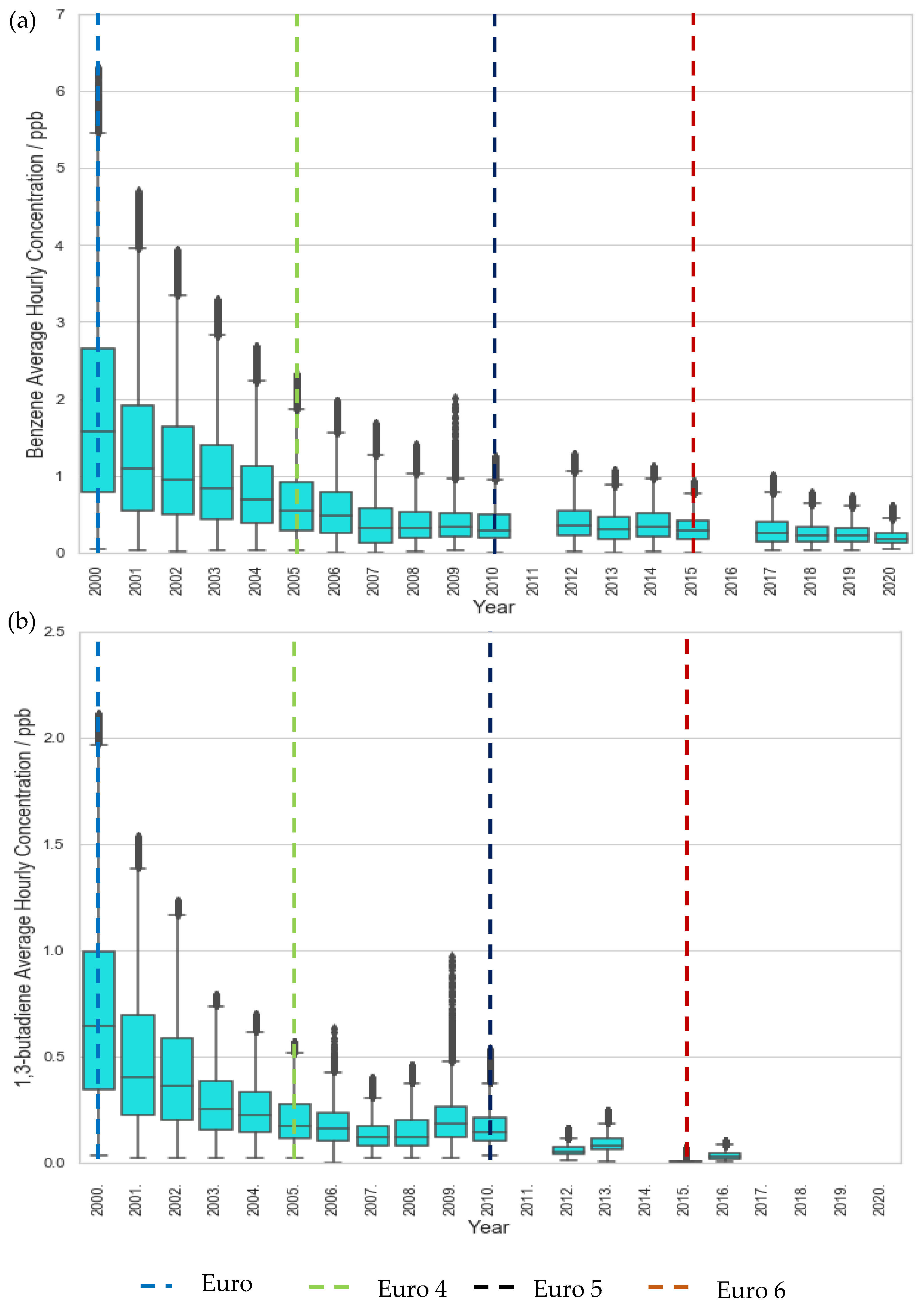
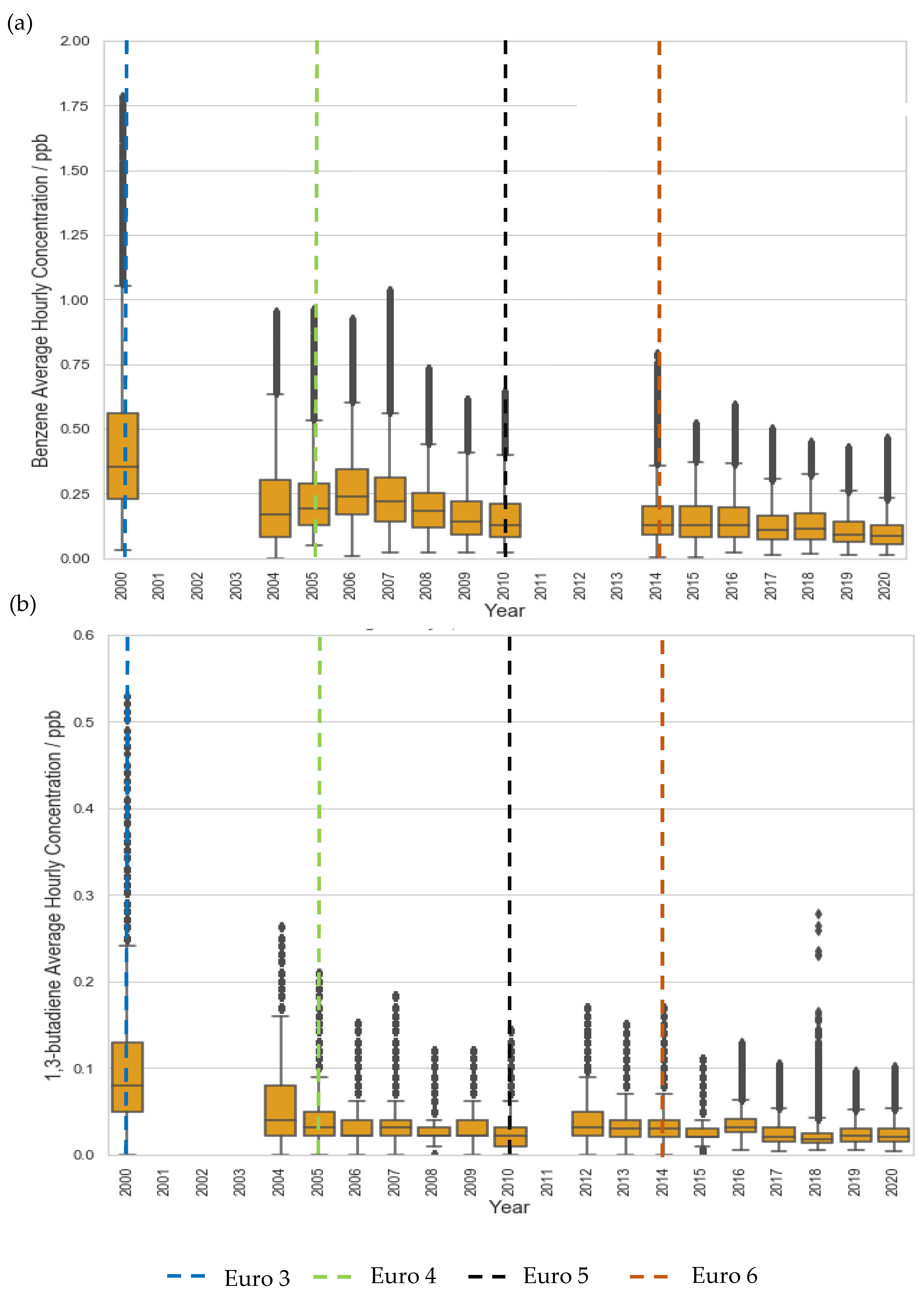
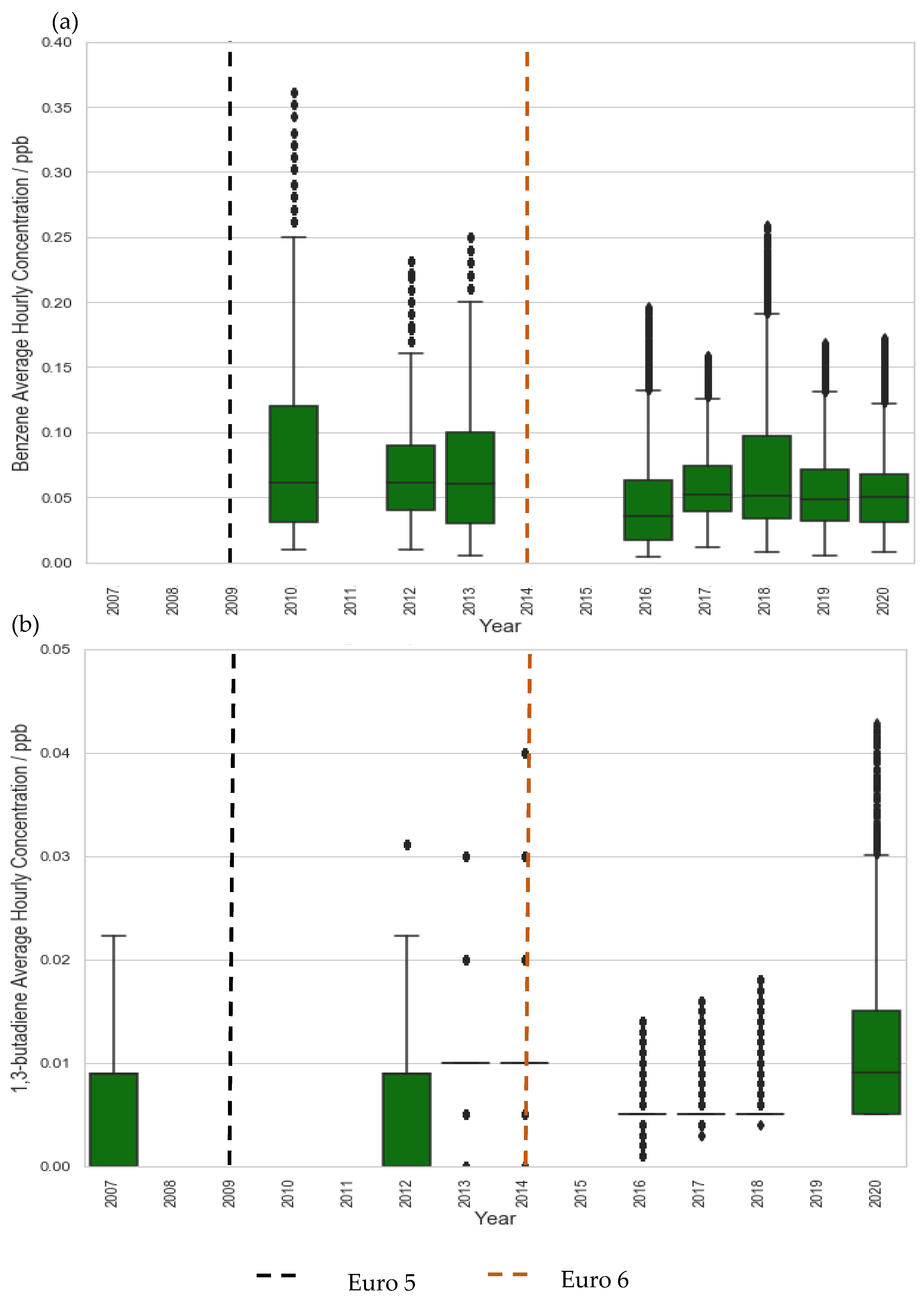
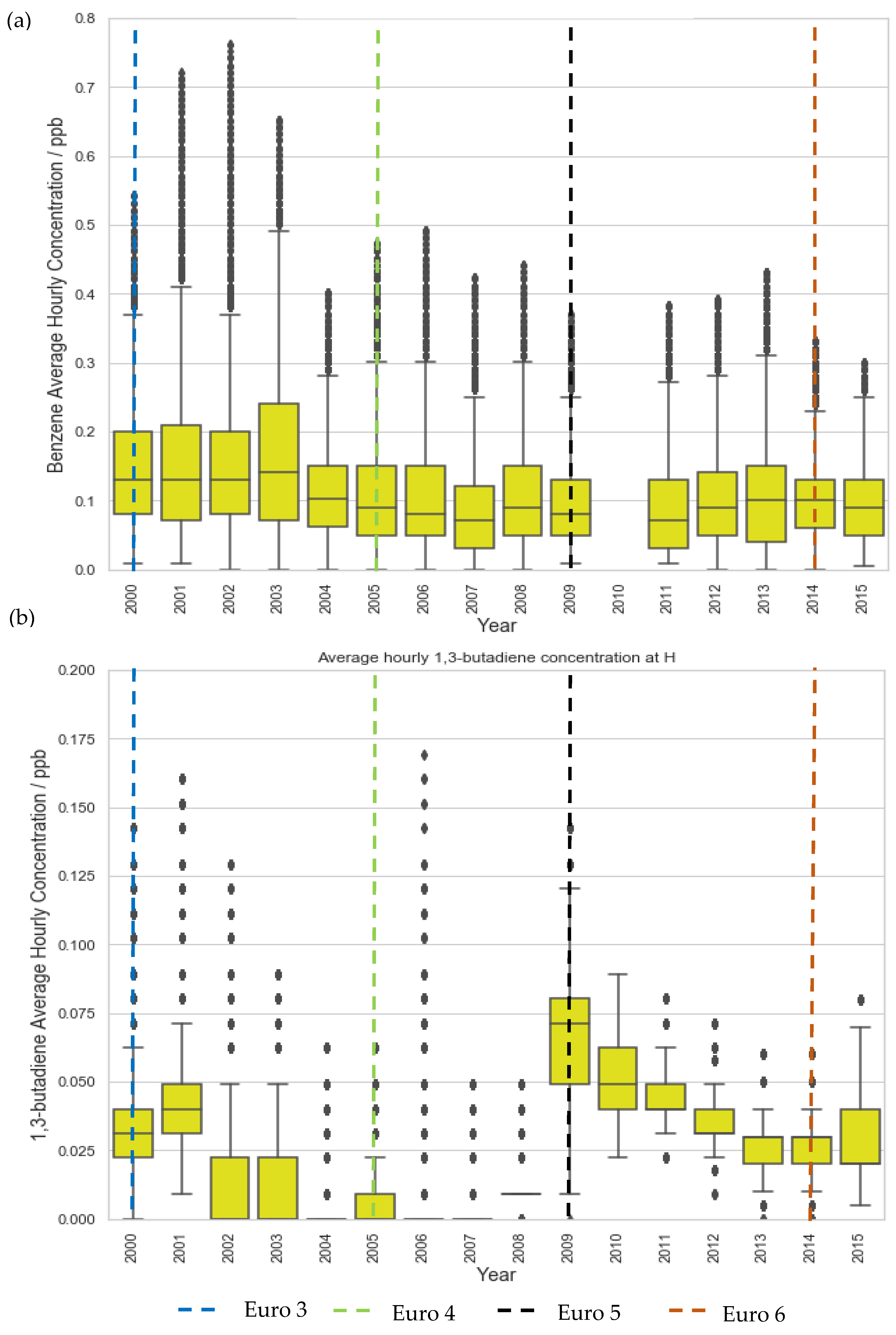

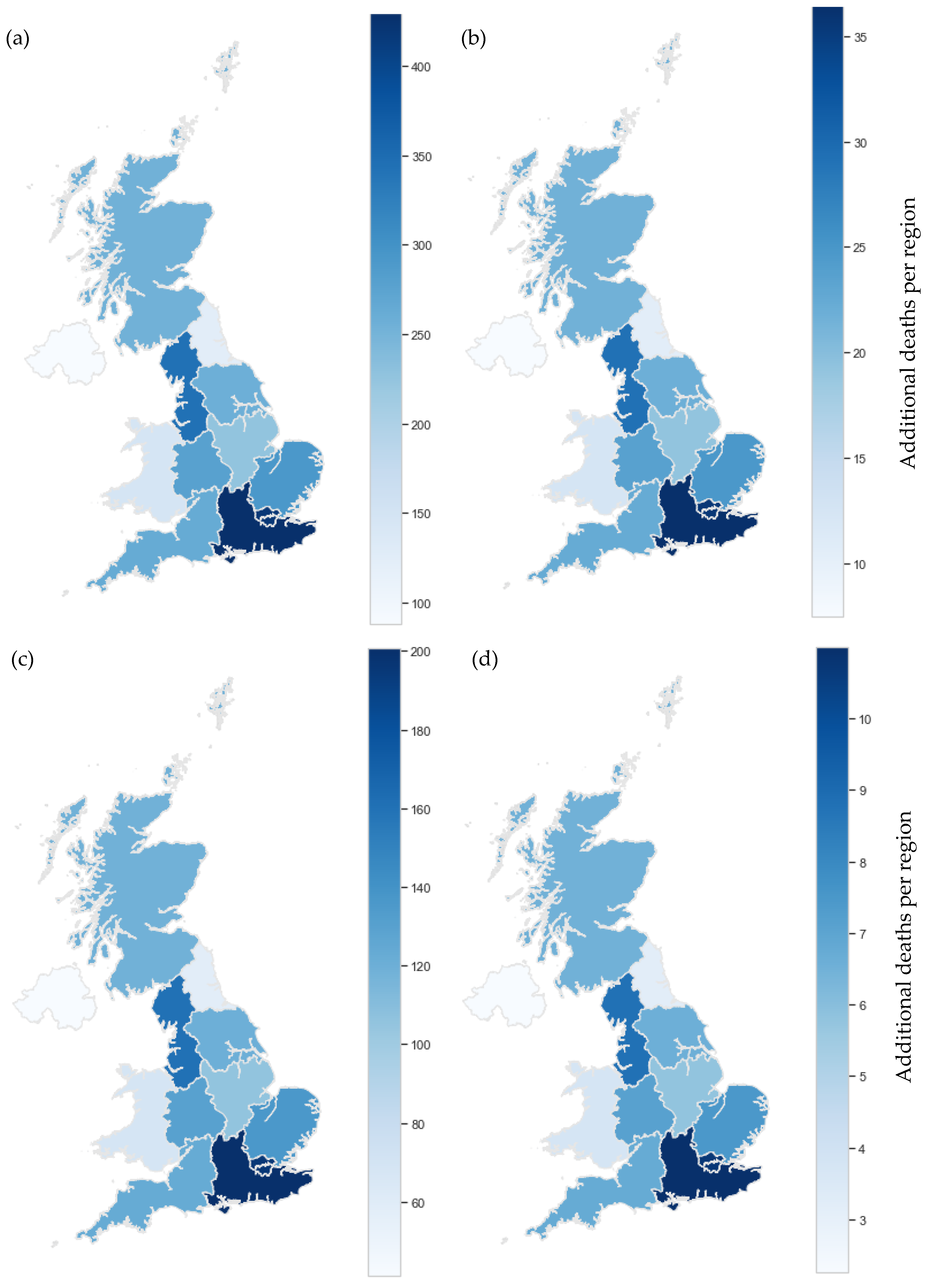
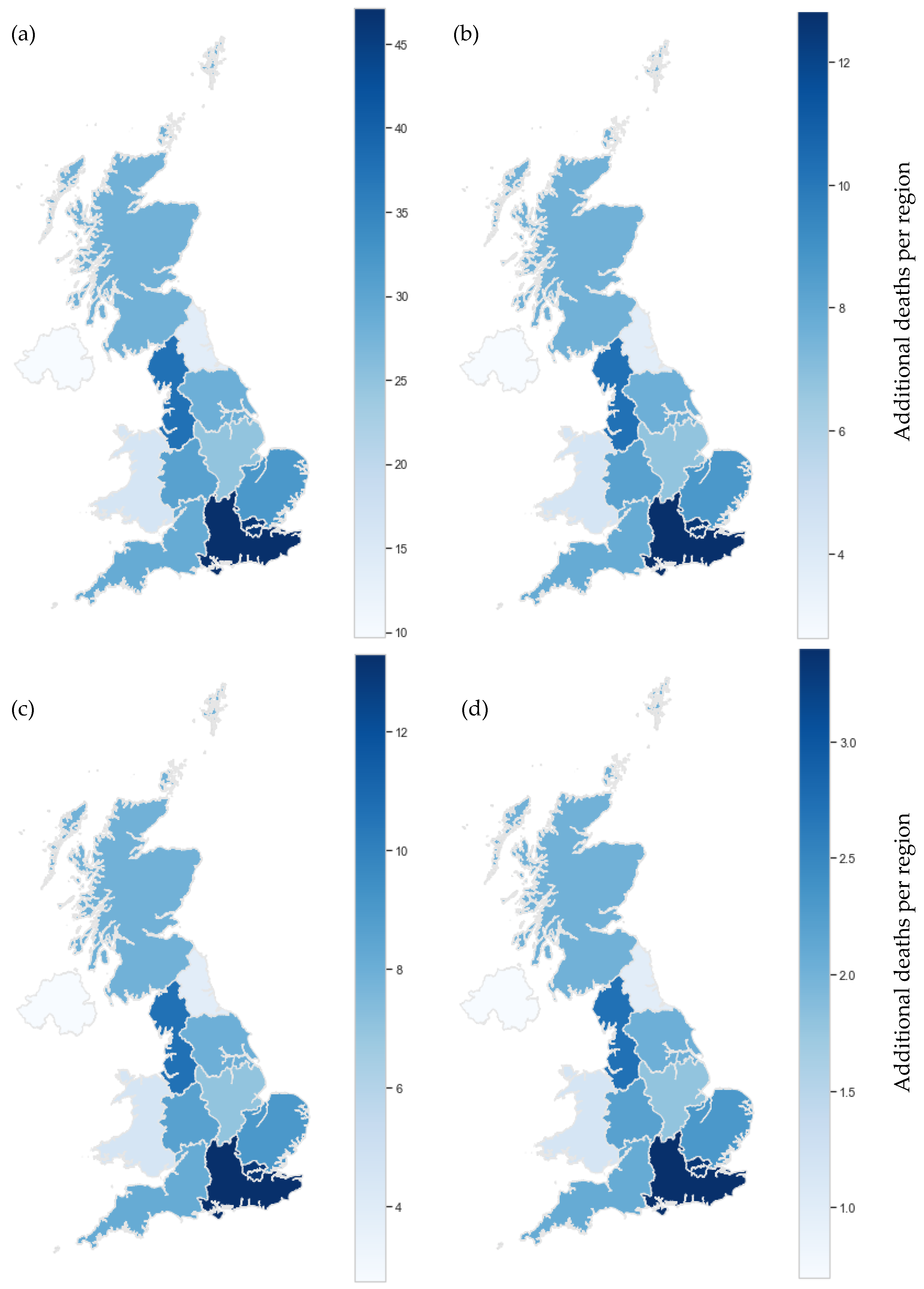
| Site | Data Availability | Overall Gradient of Line of Best Fit | Gradient of Line of Best Fit for Data 2000–2010 | Gradient of Line of Best Fit for Data 2010–2020 | |||
|---|---|---|---|---|---|---|---|
| Benzene | 1,3-Butadiene | Benzene | 1,3-Butadiene | Benzene | 1,3-Butadiene | ||
| LMR | 2000–2020 | −0.062 | −0.028 | −0.144 | −0.047 | −0.019 | −0.011 |
| LE | 2000–2020 | −0.013 | −0.003 | −0.028 | −0.009 | −0.007 | −0.001 |
| AM | 2010–2020 | −0.003 | Not significant | N/A | Not significant | −0.003 | Not significant |
| H | 2000–2015 | −0.005 | Not significant | −0.001 | Not significant | −0.001 | Not significant |
Publisher’s Note: MDPI stays neutral with regard to jurisdictional claims in published maps and institutional affiliations. |
© 2022 by the authors. Licensee MDPI, Basel, Switzerland. This article is an open access article distributed under the terms and conditions of the Creative Commons Attribution (CC BY) license (https://creativecommons.org/licenses/by/4.0/).
Share and Cite
Holland, R.; Khan, M.A.H.; Matthews, J.C.; Bonifacio, S.; Walters, R.; Koria, P.; Clowes, J.; Rodgers, K.; Jones, T.; Patel, L.; et al. Investigating the Variation of Benzene and 1,3-Butadiene in the UK during 2000–2020. Int. J. Environ. Res. Public Health 2022, 19, 11904. https://doi.org/10.3390/ijerph191911904
Holland R, Khan MAH, Matthews JC, Bonifacio S, Walters R, Koria P, Clowes J, Rodgers K, Jones T, Patel L, et al. Investigating the Variation of Benzene and 1,3-Butadiene in the UK during 2000–2020. International Journal of Environmental Research and Public Health. 2022; 19(19):11904. https://doi.org/10.3390/ijerph191911904
Chicago/Turabian StyleHolland, Rayne, M. Anwar H. Khan, James C. Matthews, Sophia Bonifacio, Rhian Walters, Priya Koria, Joanna Clowes, Karla Rodgers, Temi Jones, Leeya Patel, and et al. 2022. "Investigating the Variation of Benzene and 1,3-Butadiene in the UK during 2000–2020" International Journal of Environmental Research and Public Health 19, no. 19: 11904. https://doi.org/10.3390/ijerph191911904
APA StyleHolland, R., Khan, M. A. H., Matthews, J. C., Bonifacio, S., Walters, R., Koria, P., Clowes, J., Rodgers, K., Jones, T., Patel, L., Cross, R., Sandberg, F., & Shallcross, D. E. (2022). Investigating the Variation of Benzene and 1,3-Butadiene in the UK during 2000–2020. International Journal of Environmental Research and Public Health, 19(19), 11904. https://doi.org/10.3390/ijerph191911904








